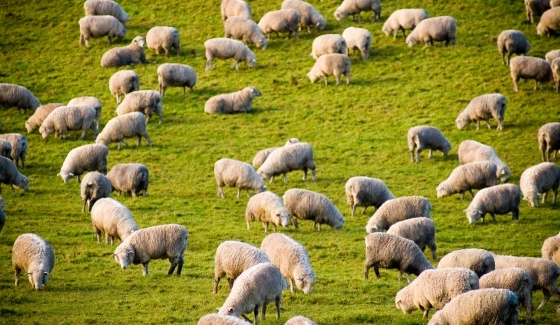
What do the numbers mean?
The less susceptible a sheep is to footrot, the lower it’s FR ASBV is. ASBVs for FR are reported as the weighted average foot score deviation from the FR NZ research database baseline (which is 0).
For example; an animal with a FR ASBV of -0.4 has a weighted average footrot score 0.4 of a score lower than the database baseline. A ram with an ASBV of -0.4 for FR will pass half of his genetics onto his progeny, which will be -0.2 of a weighted average footrot score less affected.
Susceptibility to footrot is moderately heritable (approximately 25%) meaning that a substantial proportion of the trait variation is explained by genetics.
How is it measured?
Sheep get footrot if they are genetically susceptible and exposed to virulent forms of the footrot bacteria. If the conditions are right the bacteria first infects the skin between the claws before progressing from the interdigital skin and soft horn to underrun the sole of the foot and ultimately to the hoof wall. When a footrot disease challenge has progressed enough to differentiate between unaffected and affected animals, the mob can be scored for footrot.
All four of a sheep’s feet are scored on a six-point scale from 0 - 5, with score 0 being an unaffected foot and score 5 being a foot with severe footrot progressed to the entire foot.
Sheep can only be inspected during an active, virulent outbreak of footrot when the disease is spreading and is not residual chronic untreated footrot from a previous outbreak. Therefore scores are only collected from young sheep (age 6 months – 2 years of age) in large mobs. Older sheep may have been infected and treated before.
Before foot score data is accepted by Sheep Genetics to estimate the ASBV for FR, the following challenge thresholds must first be met (for score definitions refer to figure 1 ‘Foot scores (0-5 scale)’ below):
1. 10% of animals have at least one foot that is score 3 or greater
2. 50% of animals have at least one foot that is score 2 or greater
Feet are scored at the appropriate stage of the footrot challenge and by an accredited footrot scorer.
For complete information on how you can challenge and have an accredited foot scorer score your stud sheep, contact Sheep Genetics at info@sheepgenetics.org.au or Footrot Breeding Value Project lead, Dr. Mark Ferguson at mark@nextgenagri.com.

How can I use the FR ASBV?
The FR ASBV is a tool to select sheep based on their genetic susceptibility to footrot. By breeding from less susceptible sheep, you can improve the level of tolerance to footrot in your flock over time. Sires with a lower FR ASBV will produce progeny that get infected less, have fewer affected feet and less severe footrot (fewer score 3 and 4 lesions). This will make footrot outbreaks easier to manage and reduce impact of disease on production traits i.e. fleece weight, fleece quality, lambing performance, lamb survival, bodyweight and growth rates.
There is variation in genetic susceptibility to footrot. In the below graph you can see that under a specific severe footrot challenge, a flock with an average FR ASBV of -0.5 will have a significantly lower proportion of underrun feet (foot scores 3, 4 and 5) compared to a flock with an average FR ASBV of +0.5. The bell curve on the graph represents the current FR ASBV database population.

Are there any other ways of picking the susceptible sheep?
No, you cannot predict which animals are genetically more or less susceptible to footrot any other way.
What else changes if I just select for footrot resistance?
Not much. There are no traits with strong enough genetic correlations to use as an indicator trait for susceptibility (or lack of) to footrot. There are also no genetic correlations with production traits.
What is the current scope of the FR ASBV?
At release in April 2020, the FR ASBV is entirely estimated using data from New Zealand animals. This is because the research and development data were recorded through the New Zealand Central Progeny Test, and in collaboration New Zealand stud breeders.
New Zealand studs receive reportable FR ASBVs by:
1. measuring their stud sheep’s footrot during a controlled challenge on their property or;
2. if they are genetically linked to other studs or to the Central Progeny Test, where progeny have their susceptibility to footrot scored.
Genomic testing contributes to estimating FR ASBVs but at this stage genomics alone is not sufficient to reach reportable accuracy levels.
To learn how you can collect data and gain flock linkage for the FR ASBV in your stud, please contact Sheep Genetics on info@sheepgenetics.org.au.
A word of thanks
Work on the footrot ASBV began in 2013, when the project to develop a solution to the disease started. This work was co-funded by The New Zealand Merino Company (NZM), the New Zealand Ministry for Primary Industries (MPI), Merino Inc., with support from the New Zealand fine wool stud breeding industry. The breeding value’s development was carried out in collaboration with NZM’s research partners AGBU (Animal Genetics and Breeding Unit) and neXtgen Agri Ltd.
Download this full document HERE




.webp)
.jpg)



